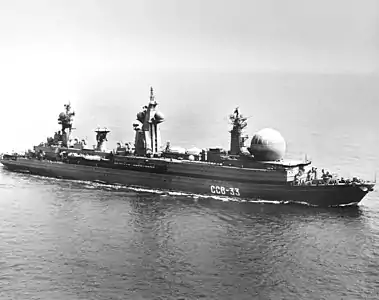Soviet communications ship SSV-33
SSV-33 Ural (ССВ-33 Урал; NATO reporting name: Kapusta, Russian for "cabbage") was a command and control naval ship operated by the Soviet Navy. SSV-33's hull was derived from that of the nuclear powered Kirov-class battlecruisers with nuclear marine propulsion.[2] SSV-33 served in electronic intelligence, missile tracking, space tracking, and communications relay roles. Due to high operating costs, SSV-33 was laid up in 1989.[2]
 SSV-33 Ural underway | |
| History | |
|---|---|
| Name | SSV 33 Ural |
| Builder | Baltic Yard, Leningrad |
| Yard number | 810 |
| Laid down | 25 June 1981 |
| Launched | May 1983 |
| Commissioned | 7 January 1989 |
| Decommissioned | 27 December 2002 |
| Fate | Scrapping commenced in 2010, completed by the end of 2018. |
| General characteristics | |
| Class and type | Project 1941 Titan (NATO "Kapusta") |
| Displacement | 32,780 tons standard; 36,500 tons full load |
| Length | 265 m (869 ft) |
| Beam | 30 m (98 ft) |
| Draught | 7.5 m (25 ft) |
| Propulsion | |
| Speed | 21.6 knots (40.0 km/h; 24.9 mph) |
| Range | unlimited |
| Complement | 950 (233 officers, 690 NCOs and enlisted men) |
| Armament | |
| Aircraft carried | 1 × Ka-32 helicopter |
| Aviation facilities | Hangar and helipad |
The onboard radio reconnaissance system was called "Coral"; this involved two computer types: "Elbrus" and several "EC-1046" computers.
SSV-33 carried only light defensive weapons. These were two AK-176 76 mm guns, four AK-630 30 mm guns, and four quadruple Igla missile mounts.
SSV-33 was assigned to the Pacific Fleet, but there was no pier large enough for the ship. She was forced to anchor out. Machinery had to remain running while at anchor to support other systems and its crew; the ship became a floating barracks. She never went to sea, while her powerful radioelectronic equipment gradually began to decay.[3]
The initial value of the ship's disposal contract was $310 million. The work was performed in the Bay of Bolshoy Kamen in Primorsky region and completed by late 2018.
In popular culture
- In the novel World War Z, by Max Brooks, Ural is based at Ulithi as the broadcast base for the worldwide radio network, Radio Free Earth.[4]
- A fictional duplicate, Ural II, is seen in the anime movie Evangelion: 2.0 You Can (Not) Advance, used as an external command centre for a NERV research base.
See also
References
- "Kirov (Orlan) class (Type 1144.1/1144.2) (CGN)". Janes.com. 8 September 2000. Archived from the original on 15 April 2009.
- Pike, John. "SSV-33 Project 1941". GlobalSecurity.org. Retrieved 30 October 2015.
- Genys, Andrius. "Ural (Command ship)". MilitaryToday.com. Archived from the original on 24 December 2013.
- Brooks, Max (2010). World War Z (Kindle ed.). Gerald Duckworth. ISBN 978-0-71563-703-6.
External links
- Toppan, Andrew (2003). "Soviet & Russian Navy - Naval Auxiliaries". Haze Gray & Underway.
- "Судно связи и управления, проект 1941" [Communication and control vessel, project 1941]. Warships.ru (in Russian). Archived from the original on 1 September 2011.
- "Large nuclear-powered intelligence ship, Project 1941 Titan". Russian-ships.info. Archived from the original on 30 November 2010.